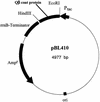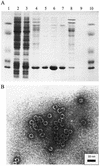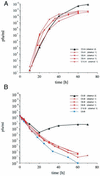Evolution of bacteriophage in continuous culture: a model system to test antiviral gene therapies for the emergence of phage escape mutants
- PMID: 11992006
- PMCID: PMC137063
- DOI: 10.1128/jvi.76.11.5784-5792.2002
Evolution of bacteriophage in continuous culture: a model system to test antiviral gene therapies for the emergence of phage escape mutants
Abstract
The emergence of viral escape mutants is usually a highly undesirable phenomenon. This phenomenon is frequently observed in antiviral drug applications for the treatment of viral infections and can undermine long-term therapeutic success. Here, we propose a strategy for evaluating a given antiviral approach in terms of its potential to provoke the appearance of resistant virus mutants. By use of Q beta RNA phage as a model system, the effect of an antiviral gene therapy, i.e., a virus-specific repressor protein expressed by a recombinant Escherichia coli host, was studied over the course of more than 100 generations. In 13 experiments carried out in parallel, 12 phage populations became resistant and 1 became extinct. Sequence analysis revealed that only two distinct phage mutants emerged in the 12 surviving phage populations. For both escape mutants, sequence variations located in the repressor binding site of the viral genomic RNA, which decrease affinity for the repressor protein, conferred resistance to translational repression. The results clearly suggest the feasibility of the proposed strategy for the evaluation of antiviral approaches in terms of their potential to allow resistant mutants to appear. In addition, the strategy proved to be a valuable tool for observing virus-specific molecular targets under the impact of antiviral drugs.
Figures





Similar articles
-
Recombinant RNA phage Q beta capsid particles synthesized and self-assembled in Escherichia coli.Gene. 1993 Dec 27;137(1):133-7. doi: 10.1016/0378-1119(93)90261-z. Gene. 1993. PMID: 7506687
-
MS2 coat protein mutants which bind Qbeta RNA.Nucleic Acids Res. 1997 Jul 15;25(14):2808-15. doi: 10.1093/nar/25.14.2808. Nucleic Acids Res. 1997. PMID: 9207028 Free PMC article.
-
Viral Q beta RNA as a high expression vector for mRNA translation in a cell-free system.FEBS Lett. 1995 Feb 6;359(1):89-92. doi: 10.1016/0014-5793(95)00006-u. FEBS Lett. 1995. PMID: 7851538
-
Analysis of phage MS2 coat protein mutants expressed from a reconstituted phagemid reveals that proline 78 is essential for viral infectivity.J Mol Biol. 1997 Feb 14;266(1):1-7. doi: 10.1006/jmbi.1996.0786. J Mol Biol. 1997. PMID: 9054964
-
The three faces of riboviral spontaneous mutation: spectrum, mode of genome replication, and mutation rate.PLoS Genet. 2012;8(7):e1002832. doi: 10.1371/journal.pgen.1002832. Epub 2012 Jul 26. PLoS Genet. 2012. PMID: 22844250 Free PMC article.
Cited by
-
In vitro Evaluation of the Antiviral Activity of an Extract of Date Palm (Phoenix dactylifera L.) Pits on a Pseudomonas Phage.Evid Based Complement Alternat Med. 2010 Mar;7(1):57-62. doi: 10.1093/ecam/nem160. Epub 2007 Oct 27. Evid Based Complement Alternat Med. 2010. PMID: 18955267 Free PMC article.
-
Automated in vitro evolution of a translation-coupled RNA replication system in a droplet flow reactor.Sci Rep. 2018 Aug 8;8(1):11867. doi: 10.1038/s41598-018-30374-0. Sci Rep. 2018. PMID: 30089835 Free PMC article.
-
Quantitative analysis of a parasitic antiviral strategy.Antimicrob Agents Chemother. 2004 Mar;48(3):1017-20. doi: 10.1128/AAC.48.3.1017-1020.2004. Antimicrob Agents Chemother. 2004. PMID: 14982798 Free PMC article.
-
Impact of epistasis and pleiotropy on evolutionary adaptation.Proc Biol Sci. 2012 Jan 22;279(1727):247-56. doi: 10.1098/rspb.2011.0870. Epub 2011 Jun 22. Proc Biol Sci. 2012. PMID: 21697174 Free PMC article.
-
High Throughput Manufacturing of Bacteriophages Using Continuous Stirred Tank Bioreactors Connected in Series to Ensure Optimum Host Bacteria Physiology for Phage Production.Viruses. 2018 Oct 1;10(10):537. doi: 10.3390/v10100537. Viruses. 2018. PMID: 30275405 Free PMC article.
References
-
- Adams, M. H. 1959. Bacteriophages. Wiley Interscience, New York, N.Y.
-
- Arora, R., C. Priano, A. B. Jacobson, and D. R. Mills. 1996. cis-acting elements within an RNA coliphage genome: fold as you please, but fold you must. J. Mol. Biol. 258:433-446. - PubMed
-
- Ball, L. A., and P. Kaesberg. 1973. A polarity gradient in the expression of the replicase gene of RNA bacteriophage Qβ. J. Mol. Biol. 74:547-562. - PubMed
-
- Bauer, G., J. S. McCaskill, H. Otten, and A. Schwienhorst. 1989. Evolution im Laboratorium. Nachrbl. Chem. Tech. Lab. 37:484-488.
Publication types
MeSH terms
Substances
LinkOut - more resources
Full Text Sources
Other Literature Sources

